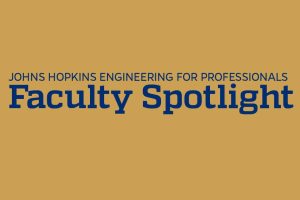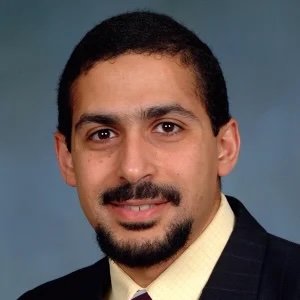
 Ali Darwish, an Engineering for Professionals (EP) instructor of electrical and computer engineering, works for the Army Research Lab (ARL) as the Radio Frequency (RF) team lead. In addition to leading the RF team at ARL, Ali is also an execution technical area lead with the MicroElectronics Commons (MEC), part of the CHIPS and Science Act. Learn more about Ali, including how he is solving some of our nation’s most challenging problems and why he enjoys teaching in the EP program.
Ali Darwish, an Engineering for Professionals (EP) instructor of electrical and computer engineering, works for the Army Research Lab (ARL) as the Radio Frequency (RF) team lead. In addition to leading the RF team at ARL, Ali is also an execution technical area lead with the MicroElectronics Commons (MEC), part of the CHIPS and Science Act. Learn more about Ali, including how he is solving some of our nation’s most challenging problems and why he enjoys teaching in the EP program.
What are the major challenges your industry is currently facing?
ARL’s mission is to discover, innovate, and transition science and technology to ensure the United States’ technological superiority. The RF team focuses on improving the performance of high-speed electronics while reducing size, weight, power, and cost. The RF electronics industry is grappling with numerous challenges. There’s a relentless push to achieve more with fewer resources—integrating additional functionality and increased bandwidth while simultaneously lowering power consumption and heat dissipation. Additionally, the chip design process is intricate, time-intensive, and costly. Meanwhile, customers are demanding swift product releases and significant performance improvements from one generation to the next.
How are you and your organization approaching these challenges?
The MEC and ARL are working to address these challenges by developing high-density heterogeneous integration and advanced packaging, which enable the use of the best semiconductor junction for the function, enable mm-wave frequencies, and speed up the prototyping process. Another key focus is the exploration of novel ultra-wide bandgap semiconductor materials like aelectronics. These materials hold the potential for exceptional performance, offering high output power density, cutoff frequencies above 100 GHz, and superior heat conductivity.
My research has concentrated on mm-wave frequencies (30 – 300 GHz) due to their potential for ultrafast speeds, highly directional communications, and high-resolution imaging. I pioneered the use of frequency multiplier-based front ends instead of conventional mixer-based designs. My team was among the first to demonstrate complex modulated signals in the 200 GHz range, achieving high spectral efficiency links. A crucial insight that enabled this breakthrough was recognizing nonlinearity as a beneficial feature rather than a limiting factor.
How do you apply your professional experience in your role as an EP instructor and what do you enjoy most about teaching in the EP program?
I am captivated by how in-depth analysis grounded in first principles can overcome long-standing limitations. The progress in RF/microwave electronics is nothing short of astonishing. Teaching in JHU’s EP program allows me to share my passion for microwave engineering with aspiring engineers and introduce them to the intriguing applications of electromagnetics.